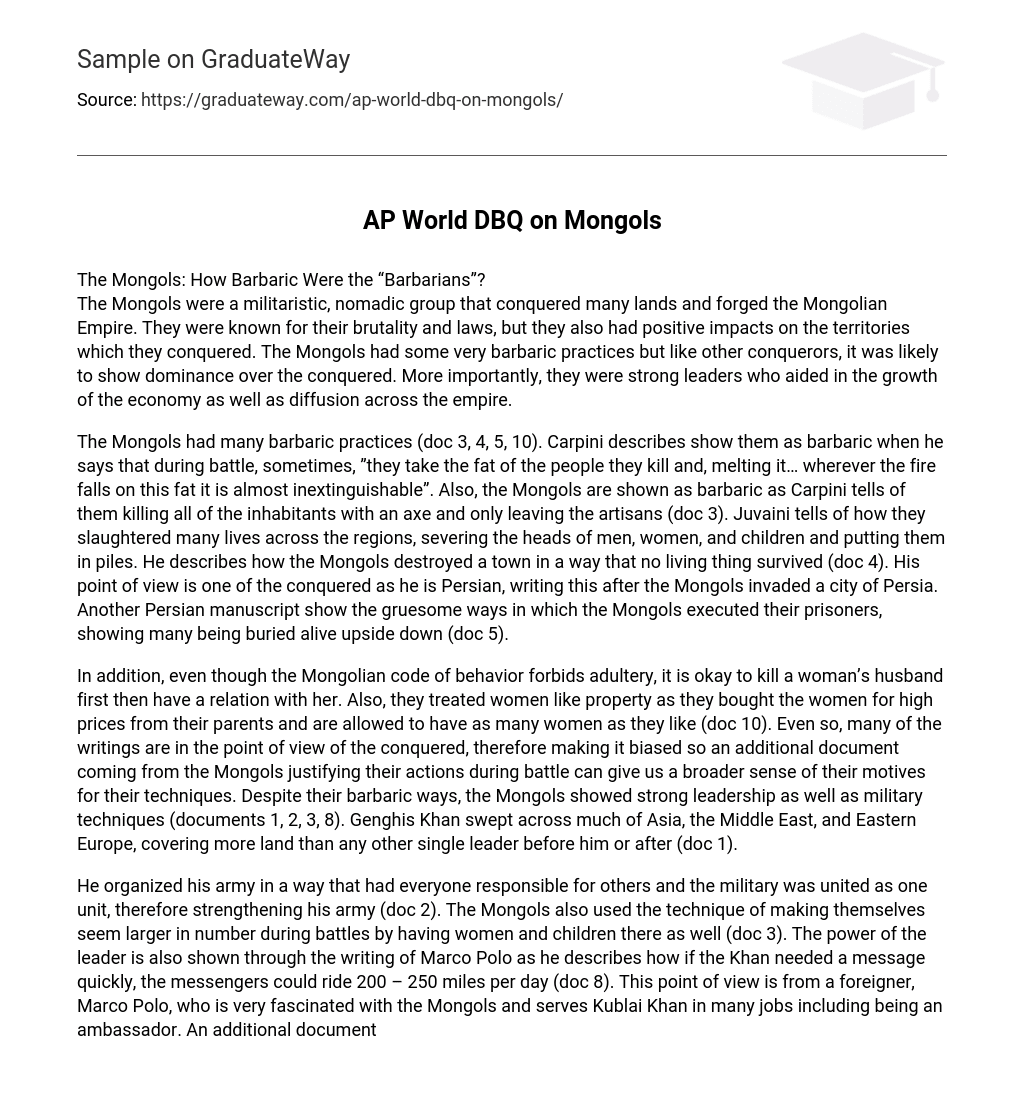The Mongols: How Barbaric Were the “Barbarians”?
The Mongols were a nomadic, militaristic group that conquered numerous lands and established the Mongolian Empire. Despite their brutal practices and laws, they also brought about positive changes in the territories they conquered. Although their actions may have seemed barbaric, such behavior was likely a means to assert dominance over the conquered. More significantly, the Mongols were effective leaders who played a pivotal role in promoting economic growth and facilitating cultural diffusion throughout the empire.
According to various documents (doc 3, 4, 5, 10), the Mongols engaged in numerous barbaric practices. Carpini portrays them as savage when he states that during battle, they would collect the fat from those they killed and melt it. He notes that wherever the fire fell on this fat, it was nearly impossible to extinguish. Additionally, Carpini describes how the Mongols would kill all the inhabitants of a place with an axe, sparing only the artisans (doc 3). Juvaini recounts how they ruthlessly slaughtered countless lives across different regions, mercilessly severing the heads of men, women, and children and piling them up. He vividly depicts how the Mongols decimated a town with such brutality that no living creature survived (doc 4). Juvaini’s perspective stems from being part of the conquered, as he writes this after the Mongols invaded a Persian city. Another Persian manuscript portrays the gruesome methods used by the Mongols to execute their prisoners, including burying many alive upside down (doc 5).
Despite the Mongolian code of behavior that forbids adultery, it was acceptable for a man to kill a woman’s husband before engaging in a relationship with her. Moreover, women were treated as commodities, being purchased at high prices from their parents and men were allowed to have multiple women. However, it is important to note that many of the accounts of the Mongols come from the perspective of those they conquered, leading to biased views. Therefore, having an additional document from the Mongols could provide a more comprehensive understanding of their motives and techniques during battle. Despite their savage tactics, the Mongols displayed strong leadership skills and military strategies. Notably, Genghis Khan’s conquests spanned across Asia, the Middle East, and Eastern Europe, encompassing more territory than any other leader in history.
In document 2, it is stated that the leader organized his army in a way that ensured everyone’s responsibility for each other, resulting in a united and strengthened military force. Document 3 reveals that the Mongols employed a tactic of appearing more numerous in battles by including women and children. Furthermore, Marco Polo, a foreigner with admiration for the Mongols, writes in document 8 about the leader’s power, highlighting the speed at which messengers could deliver messages if needed. Polo served Kublai Khan in various roles, including as an ambassador. To further enhance our understanding of the effectiveness of the techniques mentioned in document 2, an additional document from a Mongolian soldier would be valuable.
The Mongols oversaw a peaceful period known as the Pax Mongolica (doc 6, 7, 8, 9, 10). They blended with locals in China and Persia, promoting economic development (doc 6). Infrastructure such as canals and roads were also constructed for communication and transportation (doc 6, 8). Enforced laws reduced theft and robbery (doc 7). Codes of behavior maintained social stability by prescribing acceptable actions (doc 10). Mongol leaders embraced religious tolerance, allowing freedom of worship (doc 9). They often adopted the dominant religions of the regions they ruled, demonstrating their efforts to create peace.
An additional document that includes the perspective of regular people, not just scholars of the conquered people, can provide insight into how the Mongols affected the average population. This document can help determine whether they were affected or if life continued as usual. Furthermore, documents showcasing a merchant’s viewpoint would aid in understanding the full extent of the impact of the trade routes and the peace they brought. While the Mongols are often portrayed as brutal and barbaric, their influence on the world extends beyond mere slaughter. They played a role in promoting diversity through the diffusion of ideas and trade throughout their expansive empire.





